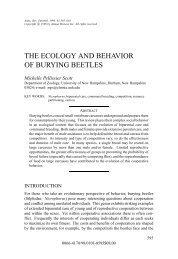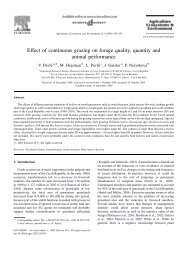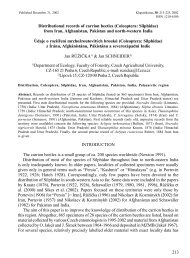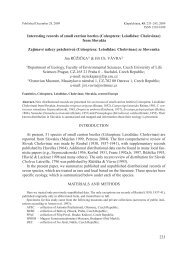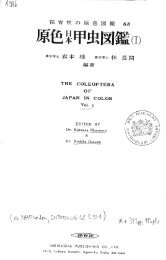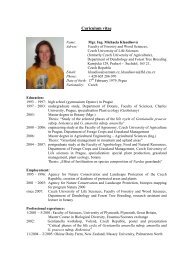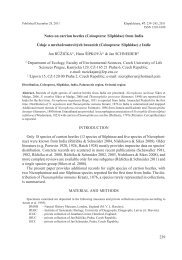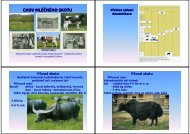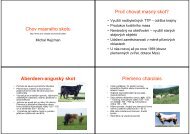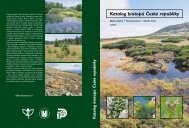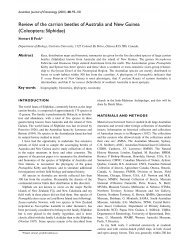<strong>ZOOTAXA</strong>65Trumbo, S.T. (1990b) Reproductive benefits of infanticide in a biparental burying beetle Nicrophorusorbicollis. Behavioral Ecology and Sociobiology, 27(4), 269-273. (biology, behavior) [fromabstract: “Use of a genetic marker demonstrated that male and female intruders obtainedreproductive benefits from infanticide.”] [!S]Trumbo, S.T. (1990c) Reproductive success, phenology and biogeography of burying beetles (Silphidae,Nicrophorus). American Midland Naturalist, 124(1), 1-11. (biology, behavior) [N.orbicollis & N. tomentosus common on mice, but N. pustulatus not; “Compared with earlierstudies in northern habitats of North America, burying beetles are less abundant, less diverseand not as successful in southeastern woodlands.”] [!S]Trumbo, S.T. (1990d) Regulation of brood size in a burying beetle, Nicrophorus tomentosus (Silphidae).Journal of Insect Behavior, 3(4), 491-500. (biology, behavior) [!N, S]Trumbo, S.T. (1991) Reproductive benefits and the duration of paternal care in a biparental buryingbeetle, Necrophorus orbicollis. Behaviour, 117(1-2), 82-105. (biology, behavior) [fromabstract: “ It was estimated that N. orbicollis males received four times the reproductive benefiton large (27-33 g) as opposed to small carcasses (10-18 g) in the field. “] [!S]Trumbo, S.T. (1992) Monogamy to communal breeding: Exploitation of a broad resource base byburying beetles (Nicrophorus). Ecological Entomology, 17(3), 289-298. (biology, behavior)[from abstract: “N. orbicollis and N. sayi are extremely dependent on parental regurgitationsand young fail to survive to the second instar if parents are removed. Young of N.defodiens, N.tomentosus and N. pustulatus can develop normally without parental regurgitations.”] [!S]Trumbo, S.T. (1994) Interspecific competition, brood parasitism, and the evolution of biparentalcooperation in burying beetles. Oikos, 69(2), 241-249. (biology, behavior) [A female willaccept heterospecific young that arrive on the carcass at the 'expected' time, but will eat larvaethat arrive > 20 h before her own eggs hatch.] [!S]Trumbo, S.T. (1995) Nesting failure in burying beetles and the origin of communal associations.Evolutionary Ecology, 9(2), 125-130. (biology, behavior) [N. defodiens more tolerant of communalbreeding than N. orbicollis.] [!S]Trumbo, S.T. (1996a) Parental care in invertebrates. Advances in the Study of Behavior, 25, 3-51.(biology, behavior) [Detailed overview of research on care in inverterbates: Prime Movers ofCare, Physiology of Care, Parental Care Theory, Uniparental vs Biparental care.] [!S]Trumbo, S.T. (1996b) The role of conflict in breeding systems: burying beetles as experimentalorganisms. American Biology Teacher, 58, 118-121. (methods, biology, behavior) [Good introto Nicrophorus trapping methods, observation methods, & conflict of interest in Nicrophorus.][!S]Trumbo, S.T. (1997) Juvenile hormone-mediated reproduction in burying beetles: From behavior tophysiology. Archives of Insect Biochemistry and Physiology, 35(4), 479-490. (Conference:biology, behavior, physiology) [Association of JH [] with behavior.] [!S]Trumbo, S.T. & Bloch, P.L. (2000) Habitat fragmentation and burying beetles abundance and success.Journal of Insect Conservation, 4, 245-252. (biology, ecology, conservation) [!S]Trumbo, S.T., Borst, D.W., & Robinson, G.E. (1995) Rapid elevation of juvenile hormone titer duringbehavioral assessment of the breeding resource by the burying beetle, Nicrophorus orbicollis.Journal of Insect Physiology, 41(6), 535-543. (biology, behavior, physiology) [JH surge infemales not triggered by mating or feeding cues.] [!S]Trumbo, S.T. & Eggert, A.-K. (1994) Beyond monogamy: Territory quality influences sexualadvertisement in male burying beetles. Animal Behaviour, 48(5), 1043-1047. (biology, ecology,behavior) [Male N. defodiens assess both resource quality & mate number when decidingwhether to emit pheromone after securing a carcass.] [!S]296 © 2002 Magnolia PressSIKES ET AL.
Trumbo, S.T. & Fernandez, A.G. (1995) Regulation of brood size by male parents and cuesemployed to assess resource size by burying beetles. Ethology Ecology & Evolution, 7(4), 313-322. (biology, behavior) [Burying beetles use a volume- but not a mass-related cue to assessresource potential.] [!S]Trumbo, S.T. & Fiore, A.J. (1991) A genetic marker for investigating paternity and maternity in theburying beetle Nicrophorus orbicollis (Coleoptera: Silphidae). Journal of the New York EntomologicalSociety, 99(4), 637-642. (biology, genetics) [Method to investigate sperm competitionin Nicrophorus.] [!S]Trumbo, S.T. & Fiore, A.J. (1994) Interspecific competition and the evolution of communal breedingin burying beetles. American Midland Naturalist, 131(1), 169-174. (biology, behavior)[Reproductive output per female was lower for group breeders.] [!S]Trumbo, S.T., Kon, M., & Sikes, D. (2001) The reproductive biology of Ptomascopus morio, abrood parasite of Nicrophorus Journal of Zoology, 255(4), 543-560. (biology, ecology, behavior)[Ptomascopus morio lacks the major behaviors of Nicrophorus associated with fast preemptionof small carcasses and appears to frequently parasitize the broods of Nicrophorus.][!S]Trumbo, S.T. & Sikes, D.S. (2000) Sexual selection and leg morphology in Nicrophorus orbicollisand Ptomascopus morio. Entomological Science, 3(4), 585-589. (in English) [!S]Trumbo, S.T. & Thomas, S. (1998) Burying beetles (Coleoptera: Silphidae) of the Apostle Islands,Wisconsin: Species diversity, population density and body size. Great Lakes Entomologist,31(2), 85-95. (biology, ecology) [Effect of competitive release on smaller species.] [!S]Trumbo, S.T. & Wilson, D.S. (1993) Brood discrimination, nest mate discrimination, and determinantsof social behavior in facultatively quasisocial beetles (Nicrophorus spp.). BehavioralEcology, 4(4), 332-339. (biology, behavior) [“Females of a species subject to a high rate ofnest failure (N. defodiens) were more likely to cooperate than females of a species with a lowrate of nest failure (N. orbicollis)”] [!S]Uetz, G.W., Van Der Laan, K.L., Summers, G.F., Gibson, P.A.K., & Getz, L.L. (1979) The effectsof flooding on floodplain arthropod distribution, abundance and community structure. AmericanMidland Naturalist, 101(2), 286-299. (comment: ecology in English) [Noted generaldecline in species richness at lower elevations with greater flood frequency.] [!S]Villada, M.M. (1901) Catálogo de la colección de coleópteros mexicanos del Museo Nacional, formaday clasificada por el Dr. D. Eugenio Dugès (Salón de Entomología). Secunda edición.Museo Nacional, México. 148 pp., 12 pls. (checklist in Spanish) [!N]Villers, C. de. (1789) Caroli Linnaei entomologia, faunae suecicae descriptionibus aucta ...Vol. 1.xvi + 765 pp., 3 pls. Piestre & Delamolliere, Lugdini. (catalog) [!N]Vitzthum, H. (1930) Milben als pestträger? Ein Beitrag zu den Untersuchungen der mandschurischenPeststudien Kommission in Harbin. Zoologische Jahrbücher (Abteilung für Systematik,Ökologie und Geographie der Tiere), 60, 381-428. (biology, symbionts: mites in German) [!N]Voigts, H & Oudemans, A.C. (1905) Zur Kenntnis der Milben-Fauna von Bremen. Abhandlungen,Naturwissenschaftlichen Verein zu Bremen, 18, 199-253. (biology, symbionts: mites in German)[Description of Neoseius novus (Acari: Uropodina) in genus Uroseius.]Vollenhoven, S.C. Snellen van. (1870) Laatste Lijst van Nederlandsche Schildvleugelige Insecten(Insecta Coleoptera). Hollandsche Maatschappij der Wetenschappen, Haarlem. v + 146 pp.(checklist in Dutch) [!N]Wachek, F. (1955) Die entoparasitischen Tylechiden. Parasitologische Schriftenreihe, 3, 1-119.(biology, parasites in German)Waldow, U. (1973) Elektrophysiologie eines neuen Aasgeruchrezeptors und seine Bedeutung fürdas Verhalten des Totengräbers (Necrophorus). Journal of Comparative Physiology, 83, 415-424. (morphology: olfactory receptors in German (English summary)) [!N, S]<strong>ZOOTAXA</strong>65CATALOG OF NICROPHORINAE© 2002 Magnolia Press 297
- Page 7 and 8:
HistoryLinnaeus named two species o
- Page 10 and 11:
ZOOTAXA65nomina nuda, misspellings,
- Page 12 and 13:
ZOOTAXA65AcknowledgementsThis proje
- Page 14 and 15:
ZOOTAXA65Available species group na
- Page 18 and 19:
ZOOTAXA peruvianus Pic, 1917; as va
- Page 20 and 21:
ZOOTAXA plagiatipennis Lewis, 1879;
- Page 22 and 23:
ZOOTAXA 1790 Olivier: no. 10, p. 6
- Page 24 and 25:
ZOOTAXA 1989 Kozol: 1-10 (biology,
- Page 26 and 27:
ZOOTAXA 1868 Gemminger & Harold: 71
- Page 28 and 29:
ZOOTAXA 1970 Franz: 213 (checklist,
- Page 30 and 31:
ZOOTAXA 1933 Semenov-Tian-Shanskij:
- Page 32 and 33:
ZOOTAXA 1895b Reitter: 326 (descrip
- Page 34 and 35:
ZOOTAXA 1986 Anderson & Peck: 283 (
- Page 36 and 37:
ZOOTAXA65Florida. The melanic popul
- Page 38 and 39:
ZOOTAXA 1986 Cho & Lee: 20 (phyloge
- Page 40 and 41:
ZOOTAXA65N. confusus and N. sepulto
- Page 42 and 43:
ZOOTAXA 1884 Marseul: 185 (key, des
- Page 44 and 45:
ZOOTAXA 1990 Peck: 1123 (key)651990
- Page 46 and 47:
ZOOTAXA 1870 Motschulsky: 352 (desc
- Page 48 and 49:
ZOOTAXA = flexuosus Portevin,192465
- Page 50 and 51:
ZOOTAXA 1761 Sulzer: pl. 2, fig. 10
- Page 52 and 53:
ZOOTAXA 1889 Fowler: 43 (descriptio
- Page 54 and 55:
ZOOTAXA 1983 Putman: 38-42 (biology
- Page 56 and 57:
ZOOTAXA 2002 Nikolajev & Kozminykh:
- Page 58 and 59:
ZOOTAXA 1895b Reitter: 324 (descrip
- Page 60 and 61:
ZOOTAXA 1884 Marseul: 184 (key, des
- Page 62 and 63:
ZOOTAXA 1930 Roubal: 240 (catalog i
- Page 64 and 65:
ZOOTAXA 1910 Barkowski: 80 (key, de
- Page 66 and 67:
ZOOTAXA 1928 Hatch: 130 (catalog)65
- Page 68 and 69:
ZOOTAXA 1870 Vollenhoven et al.: 54
- Page 70 and 71:
ZOOTAXA 1939 Lengerken: 263 (biolog
- Page 72 and 73:
ZOOTAXA 1986 Nishikawa: 99 (catalog
- Page 74 and 75:
ZOOTAXA 1909 Bickhardt: 75 (descrip
- Page 76 and 77:
ZOOTAXA Nicrophorus hybridus Hatch
- Page 78 and 79:
ZOOTAXA65“PARALECTOTYPE Nicrophor
- Page 80 and 81:
ZOOTAXA 1944 Arnett: 7 (morphology:
- Page 82 and 83:
ZOOTAXA 1882 Gradl: 331 (descriptio
- Page 84 and 85:
ZOOTAXA 1993b Kozminykh: 65 (key, d
- Page 86 and 87:
ZOOTAXA 1965b Roussel: 6452 (morpho
- Page 88 and 89:
ZOOTAXA 1926a Portevin: 257 (revisi
- Page 90 and 91:
ZOOTAXA = pasqueti Pic, 1917 NEW ST
- Page 92 and 93:
ZOOTAXA65Lectotype data for Nicroph
- Page 94 and 95:
ZOOTAXA 1891 Heyden et al.: 138 (ch
- Page 96 and 97:
ZOOTAXA 1971 Freude: 194 (key in Ge
- Page 98 and 99:
ZOOTAXA 1995 Kozminykh: 110 (key in
- Page 100 and 101:
ZOOTAXA65Type depository: MCZC: Cam
- Page 102 and 103:
ZOOTAXA 1868 Gemminger & Harold: 71
- Page 104 and 105:
ZOOTAXA 1925 Winkler: 264 (catalog)
- Page 106 and 107:
ZOOTAXA65Type depository: MZHF: Hel
- Page 108 and 109:
ZOOTAXA 1866 Marseul: 38 (catalog i
- Page 110 and 111:
ZOOTAXA 1926a Portevin: 222 (revisi
- Page 112 and 113:
ZOOTAXA 1866 Michow: 411 (descripti
- Page 114 and 115:
ZOOTAXA 1899 Ganglbauer: 164 (descr
- Page 116 and 117:
ZOOTAXA65from reduced to absent, bu
- Page 118 and 119:
ZOOTAXA Paralectotype data “17/67
- Page 120 and 121:
ZOOTAXA Nicrophorus maculifrons Kra
- Page 122 and 123:
ZOOTAXA 1955b Nakane: 54 (key, desc
- Page 124 and 125:
ZOOTAXA 1911 Wickham: 10 (checklist
- Page 126 and 127:
ZOOTAXA 2000 Sikes & Peck: 395 (des
- Page 128 and 129:
ZOOTAXA65with the elytral fascia sh
- Page 130 and 131:
ZOOTAXA 1975a Emetz: 60 (checklist
- Page 132 and 133:
ZOOTAXA65border “LECTOTYPE Nicrop
- Page 134 and 135:
ZOOTAXA 1992 Kozminykh: 64 (checkli
- Page 136 and 137:
ZOOTAXA 1879 Dohrn: 459 (comment in
- Page 138 and 139:
ZOOTAXA Nicrophorus nigricornis Fal
- Page 140 and 141:
ZOOTAXA 1920 Leng: 86 (catalog) >>
- Page 142 and 143:
ZOOTAXA 1925 Winkler: 264 (catalog)
- Page 144 and 145:
ZOOTAXA65Type depository: BMNH: Lon
- Page 146 and 147:
ZOOTAXA 1933 Wolcott & Montgomery:
- Page 148 and 149:
ZOOTAXA 1994 Beninger: 135-143 (bio
- Page 150 and 151:
ZOOTAXA Nicrophorus podagricus Port
- Page 152 and 153:
ZOOTAXA 1999 Háva et al.: 76 (key,
- Page 154 and 155:
ZOOTAXA 1982c Anderson: 1316 (biolo
- Page 156 and 157:
ZOOTAXA Nicrophorus quadraticollis
- Page 158 and 159:
ZOOTAXA 1933 Semenov-Tian-Shanskij:
- Page 160 and 161:
ZOOTAXA 1994a Ôhara: 58 (checklist
- Page 162 and 163:
ZOOTAXA 1895b Reitter: 324 (descrip
- Page 164 and 165:
ZOOTAXA 1985 Peck & Anderson: 287 (
- Page 166 and 167:
ZOOTAXA Nicrophorus scrutator Blanc
- Page 168 and 169:
ZOOTAXA 1859 Schaum: 36 (catalog in
- Page 170 and 171:
ZOOTAXA 1849 Bach: 153 (checklist,
- Page 172 and 173:
ZOOTAXA 1980 Franssen: 46 (morpholo
- Page 174 and 175:
ZOOTAXA 1887 Lewis: 341 (descriptio
- Page 176 and 177:
ZOOTAXA65139.48°E,]19-24 August 18
- Page 178 and 179:
ZOOTAXA 1970 Gersdorf: 366 (morphol
- Page 180 and 181:
ZOOTAXA 1998b Scott: 598+ (biology,
- Page 182 and 183:
ZOOTAXA 1944 Arnett: 5 (morphology:
- Page 184 and 185:
ZOOTAXA 1761 Rösel von Rosenhof: 2
- Page 186 and 187:
ZOOTAXA 1873 Klika: 127 (checklist
- Page 188 and 189:
ZOOTAXA 1939 Székessy: 943 (morpho
- Page 190 and 191:
ZOOTAXA 1987 Jensen: 116 (biology,
- Page 192 and 193:
ZOOTAXA 1881 Westhoff: 108 (descrip
- Page 194 and 195:
ZOOTAXA65Type depository: LNMD: Mü
- Page 196 and 197:
ZOOTAXA 1888 Seidlitz: 313 (key in
- Page 198 and 199:
ZOOTAXA 1948 Clark: 27 (checklist)6
- Page 200 and 201:
ZOOTAXA 1982 Wisiniewski (biology,
- Page 202 and 203:
ZOOTAXA 1993 RÉÓigka: 34 (checkli
- Page 204 and 205:
ZOOTAXA = aurora Motschulsky, 1860
- Page 206 and 207:
ZOOTAXA 1937 Leech: 156 (nomenclatu
- Page 208 and 209:
ZOOTAXA 1885 Marseul: 169 (catalog
- Page 210 and 211:
ZOOTAXA 1937 Leech: 156 (nomenclatu
- Page 212 and 213:
ZOOTAXA Nicrophorus vestigator Hers
- Page 214 and 215:
ZOOTAXA 1922 Sherborn: 6882 (catalo
- Page 216 and 217:
ZOOTAXA65Spanish)2002 Nikolajev & K
- Page 218 and 219:
ZOOTAXA 1902 Heyden: 12 (nomenclatu
- Page 220 and 221:
ZOOTAXA = olfactor Gistel, 1848 NEW
- Page 222 and 223:
ZOOTAXA PTOMASCOPUS Kraatz, 1876: 3
- Page 224 and 225:
ZOOTAXA65Type depository: BMNH: Lon
- Page 226 and 227:
ZOOTAXA 1925 Winkler: 265 (catalog)
- Page 228 and 229:
ZOOTAXA Ptomascopus zhangla Háva,
- Page 230 and 231:
ZOOTAXA65ReferencesAbbott, C.E. (19
- Page 232 and 233:
ZOOTAXA65nepalensis are more closel
- Page 234 and 235:
ZOOTAXA65Bedick, J.C. (1997) Distri
- Page 236 and 237:
ZOOTAXA65Blanchard, É. (1842) Inse
- Page 238 and 239:
ZOOTAXA65description of N. didymus.
- Page 240 and 241:
ZOOTAXA65Conley, M.R. (1982) Carrio
- Page 242 and 243:
65ZOOTAXA Delahon, P. (1913) Nachtr
- Page 244 and 245:
ZOOTAXA65Eisfelder, I. (1963) Käfe
- Page 246 and 247: ZOOTAXA65Faldermann, F. (1835a) Add
- Page 248 and 249: ZOOTAXA65Gaubil, J. (1849) Catalogu
- Page 250 and 251: ZOOTAXA65Gwiazdowicz, D.J. (2000) M
- Page 252 and 253: ZOOTAXA65Hausmann, J.F.L. (1799) En
- Page 254 and 255: ZOOTAXA65Hlisnikovsky, J. (1942) Co
- Page 256 and 257: ZOOTAXA65Jakovlev, B.E. (1887) Col
- Page 258 and 259: ZOOTAXA65Kirby, W. & Spence, W. (18
- Page 260 and 261: ZOOTAXA65Kozminykh, V.O. (1997) Fau
- Page 262 and 263: ZOOTAXA65Labitte, A. (1916) Longév
- Page 264 and 265: ZOOTAXA65Lindroth, C.H. & Ball, G.E
- Page 266 and 267: 65ZOOTAXA Marseul, S.-A. (1866) Cat
- Page 268 and 269: ZOOTAXA65Miller, S.E. & Miller, P.M
- Page 270 and 271: ZOOTAXA65Müller, J.K. & Dressel, J
- Page 272 and 273: ZOOTAXA65Newman, E. (1838) Entomolo
- Page 274 and 275: ZOOTAXA65Opler, P.A. [ed.] (1985) S
- Page 276 and 277: ZOOTAXA65Peck, S.B. & Miller, S.E.
- Page 278 and 279: ZOOTAXA65Portevin, G. (1914a) Silph
- Page 280 and 281: ZOOTAXA65Ranson, J. (1864) Fecundit
- Page 282 and 283: ZOOTAXA65Riha, P. (1949) Nova odchy
- Page 284 and 285: ZOOTAXA65RÉÓigka, J. (1999) Beetl
- Page 286 and 287: ZOOTAXA65Schneider, P. (1978) Die F
- Page 288 and 289: ZOOTAXA65Schweitzer, D.F. & Master,
- Page 290 and 291: 65ZOOTAXA (revision: key, descripti
- Page 292 and 293: ZOOTAXA65Smith, R.J., Hines, A., Ri
- Page 294 and 295: ZOOTAXA65Stroud, C.P. (1950) A surv
- Page 298 and 299: ZOOTAXA65Walkden, H.H. (1944) Insec
- Page 300 and 301: ZOOTAXA65Xambeu, P. (1892) Moeurs e
- Page 302 and 303: ZOOTAXA65Index (continued)Nicrophor
- Page 304: ZOOTAXA65Index (continued)Nicrophor



